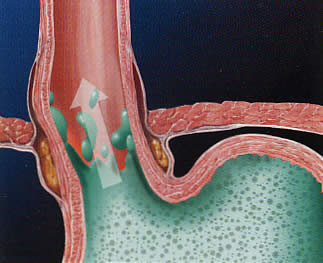
Stomach acid 'refluxing' up into the oesophagus
In gastro-oesophageal reflux disease (GORD), stomach acid 'refluxes' (goes up) into the oesophagus (gullet). While the stomach lining is designed to be bathed in acid, the oesophageal lining is not - which is why the gullet becomes inflamed & gives rise to the dyspepsia, heart-burn & pain in upper abdomen that are so often seen in GORD.
Why acid reflux occurs is an interesting question. There is a complex arrangement that normally prevents reflux, and much of this mechanism depends upon the precise position of the junction between the two (the 'gastro-oesophageal junction' or GOJ) and surrounding tissues. Most GORD patients have a hiatus hernia - where the stomach has moved upwards & herniated out of the abdominal cavity into the chest. It is likely that this abnormal position reduces the ability of the gastro-oesophageal junction to prevent reflux.
|
In Laparoscopic Nissen Fundoplication, the stomach is first brought down to its porper position. The defect in the diaphragm (the muscle separating the abdomen from the chest) is repaired by stitches. Finally, part of the stomach (its 'fundus') is wrapped around the lower oesophagus to buttress the gasto-oesophageal junction from the outside, & thus make it stronger (as seen in this diagram from Wikipedia)
What can I eat after my hiatus hernia repair?
| |
During your operation, a part of your stomach is loosely wrapped around your lower gullet(oesophagus). The wrap is designed to be loose so that it does not constrict your gullet. However, for several weeks after the operation the wrap will be swollen. This could cause some foods to become
stuck in your lower gullet. The swelling will settle completely by six weeks, but until then, you must be
careful about what you eat.
|
Weeks 1 - 3: Clear fluids and soft sloppy diet
| |
You can start drinking within a few hours of the operation. Drink in small amounts, avoiding big gulps. The clear drinks can include water, tea, most juices, squash and clear soups. You can even eat ice cream as long as it has melted before being swallowed.
Avoid fizzy drinks and alcohol. Some people suggest that caffeine and citrus juices (such as orange juice) are also best avoided.
You can start eating a soft sloppy diet from the day after your operation. Sloppy food is any food that is moist, can be broken into pieces with a fork, and does not require a lot of chewing. Examples include cereals that have been softened in milk, smooth soup (no lumps) and pureed foods.
You must not eat breads, crackers, biscuits, chunky meats such as steaks and dry meals such as cold cuts.
|
Weeks 4 and 5: Soft diet
| |
You can now start eating soft food such as well cooked pasta, minced meat, flaked fish, well cooked rice, pulses and vegetables with plenty of sauce.
|
Week 6: Normal diet
| |
If you have progressed without difficulty through the soft diet, you can start to eat a normal diet in the sixth week. Leave bread (especially white bread) and chicken until last as these have the greatest tendency to get stuck in your gullet.
If you are having difficulty with the soft diet, avoid a normal diet until you have your follow-up with your surgeon.
|
|
|
|